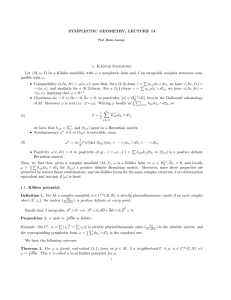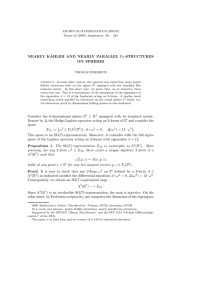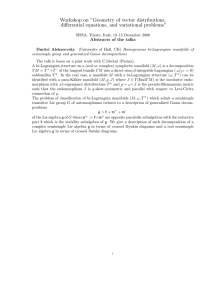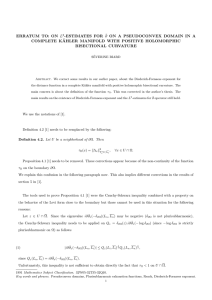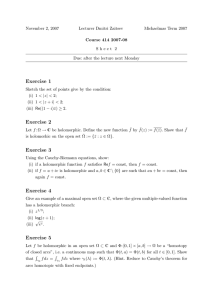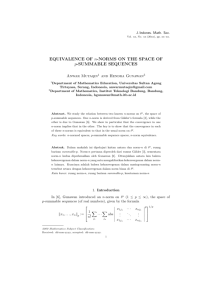HYPERK ¨ AHLER MANIFOLDS 1. Hyperk¨ ahler manifolds
advertisement
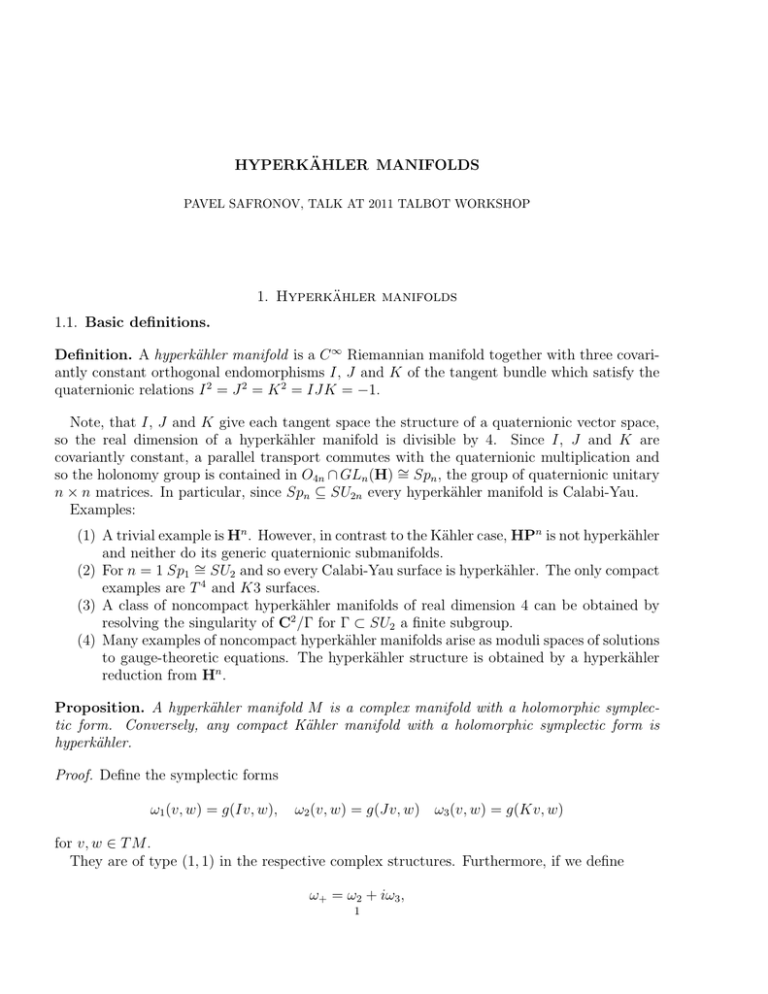
HYPERKÄHLER MANIFOLDS
PAVEL SAFRONOV, TALK AT 2011 TALBOT WORKSHOP
1. Hyperkähler manifolds
1.1. Basic definitions.
Definition. A hyperkähler manifold is a C ∞ Riemannian manifold together with three covariantly constant orthogonal endomorphisms I, J and K of the tangent bundle which satisfy the
quaternionic relations I 2 = J 2 = K 2 = IJK = −1.
Note, that I, J and K give each tangent space the structure of a quaternionic vector space,
so the real dimension of a hyperkähler manifold is divisible by 4. Since I, J and K are
covariantly constant, a parallel transport commutes with the quaternionic multiplication and
so the holonomy group is contained in O4n ∩ GLn (H) ∼
= Spn , the group of quaternionic unitary
n × n matrices. In particular, since Spn ⊆ SU2n every hyperkähler manifold is Calabi-Yau.
Examples:
(1) A trivial example is Hn . However, in contrast to the Kähler case, HPn is not hyperkähler
and neither do its generic quaternionic submanifolds.
(2) For n = 1 Sp1 ∼
= SU2 and so every Calabi-Yau surface is hyperkähler. The only compact
examples are T 4 and K3 surfaces.
(3) A class of noncompact hyperkähler manifolds of real dimension 4 can be obtained by
resolving the singularity of C2 /Γ for Γ ⊂ SU2 a finite subgroup.
(4) Many examples of noncompact hyperkähler manifolds arise as moduli spaces of solutions
to gauge-theoretic equations. The hyperkähler structure is obtained by a hyperkähler
reduction from Hn .
Proposition. A hyperkähler manifold M is a complex manifold with a holomorphic symplectic form. Conversely, any compact Kähler manifold with a holomorphic symplectic form is
hyperkähler.
Proof. Define the symplectic forms
ω1 (v, w) = g(Iv, w),
ω2 (v, w) = g(Jv, w) ω3 (v, w) = g(Kv, w)
for v, w ∈ T M .
They are of type (1, 1) in the respective complex structures. Furthermore, if we define
ω+ = ω2 + iω3 ,
1
2
PAVEL SAFRONOV, TALK AT 2011 TALBOT WORKSHOP
it is closed, non-degenerate and covariantly constant. It is holomorphic in the complex structure
I. Indeed, for any vectors v, w ∈ TC M :
ω+ (v, (1 + iI)w) = g(Jv, (1 + iI)w) + ig(Kv, (1 + iI)w)
= g(Jv, w) + ig(Kv, w) + ig(IJv, −w) − g(IKv, −w)
= g(Jv, w) + ig(Kv, w) − ig(Kv, w) − g(Jv, w) = 0.
Therefore, it is a holomorphic symplectic form.
Conversely, suppose ω is a holomorphic symplectic form on a Kähler manifold M of real
dimension 2n. Then ω n is a nowhere vanishing section of the canonical bundle which gives a
holomorphic trivialization. Yau’s theorem ensures the existence of a Kähler metric g with vanishing Ricci tensor. Applying Bochner’s theorem one concludes that ω is covariantly constant
with respect to g. Hence, the holonomy group of M is contained in Sp2n (C) ∩ U2n ∼
= Spn , i.e.
M is hyperkähler.
1.2. Twistor space. One can attempt to encode the data of hyperkähler manifold (M, g) in
a simpler complex manifold called the twistor space [Hi-92].
Observe, that for any u = (a1 , a2 , a3 ) ∈ R3
Iu2 = (a1 I + a2 J + a3 K)2 = −(a21 + a22 + a23 ).
So, if ||u|| = 1, Iu is an almost complex structure which is covariantly constant and therefore
integrable.
Define the twistor space to be a C ∞ manifold Z = M × S 2 . S 2 ∼
= CP1 has a natural complex
structure I0 , so there is an almost complex structure I on Z given by
Ip,u (v, w) = (Iu v, I0 w),
where (p, u) ∈ Z, v ∈ Tp M and w ∈ Tu S 2 .
Lemma. I is integrable.
Proof. The proof involves a use of Newlander-Nirenberg theorem.
Remark: Newlander-Nirenberg theorem fails for Hilbert manifolds, so the integrability of the
complex structure on the twistor space of a Hilbert hyperkähler manifold has to be established
independently.
We have the following
Theorem 1. The twistor space Z of a hyperkähler manifold M is a complex manifold of dimension 2n + 1, which has the following structures:
(1) A holomorphic fiber bundle p : Z → CP1 .
(2) Z has a real structure σ : V
Z → Z covering the antipodal map of CP1 .
∗
∗
(3) There is a section $ of 2 TZ/CP
1 ⊗ p O(2) which defines a holomorphic symplectic
form on each fiber and which is real with respect to σ.
(4) The bundle admits a family of global holomorphic sections, whose normal bundles are
all holomorphically isomorphic to C2n ⊗C p∗ O(1) and which are real with respect to σ.
Proof.
(1) The projection p : Z → CP1 defined by (m, ζ) → ζ is holomorphic by the
definition of the complex structure I.
HYPERKÄHLER MANIFOLDS
3
(2) The antipodal map σ̃ : S 2 → S 2 extends to an antiholmorphic involution σ : Z → Z,
since (Iu , I0 ) 7→ (−Iu , −I0 ).
(3) Recall, that ω+ = ω2 + iω3 is holomorphic in the complex structure I. Similarly, define
$(ζ) = ω2 + iω3 + 2ζω1 − ζ 2 (ω2 − iω3 ).
$(ζ) is holomorphic in the complex structure Iu and defines V
a holomorphic symplectic
∗
∗
form on p−1 (ζ). Globally, it can be extended into a section of 2 TZ/CP
1 ⊗ p O(2). The
O(2) twist is due to the quadratic dependence of $(ζ) on ζ.
(4) For each point m ∈ M , {m} × S 2 ⊂ Z is a section of Z → CP1 which is holomorphic.
Its normal bundle is isomorphic to C2n ⊗C p∗ O(1). These sections are clearly real with
respect to σ.
Conversely, starting from such data we can recover the hyperkähler manifold M .
Theorem 2. Suppose a complex manifold Z of dimension 2n + 1 has the structures (1)-(3)
given by the previous theorem. Then the parameter space of real sections (4) is a hyperkähler
manifold whose twistor space is Z.
1.3. Hyperkähler quotient. Suppose that M is a hyperkähler manifold and a compact Lie
group K acts preserving the symplectic forms ω1 , ω2 , ω3 . Then we have three moment maps
µ1 , µ2 , µ3 , or, equivalently, a single moment map
µ : M → k∗ ⊗ R3 .
Denote z ⊂ k∗ the space of K-invariants. Then we have the following
Theorem 3. If ζ ∈ z ⊗ R3 is a regular value, then µ−1 (ζ)/K is a hyperkähler manifold.
We can characterize hyperkähler quotients in a different way.
Form µ+ = µ1 + iµ2 and then the hyperkähler quotient is the symplectic quotient of a Kähler
manifold µ−1
+ (α), where α ∈ z ⊗ C.
Finally, consider the twistor point of view. Let Z → CP1 be a twistor space for M . Then
the twistor space for the hyperkähler quotient is the fiberwise symplectic quotient of Z by the
holomorphic action of G.
2. Twistor space for the moduli space
In this section X is a smooth projective variety over C. G will denote a connected reductive
complex group and K is its maximal compact subgroup.
2.1. Quotient construction of the hyperkähler structure. The following is due to Hitchin
[Hi-87] for X being a curve and Fujiki [Fu] in higher dimensions.
First, fix a C ∞ principal G-bundle P → X and a reduction PK → X of the structure group
to K. We will assume that P has a vanishing first and second Chern classes. Fix an integer
k ≥ dim X + 1.
Define the group of complex gauge transformations to be G = Γ(X, Ad P ), where the sections
are of class Hk+1 , it is naturally a Hilbert Lie group. Similarly, there is a group of real gauge
transformations K = Γ(X, Ad PK ). We have a decomposition ad P = ad PK ⊕ i ad PK , which
4
PAVEL SAFRONOV, TALK AT 2011 TALBOT WORKSHOP
gives ad P a complex structure. The space of all connections on P (PK ) of class Hk will be
denoted by A (AK ).
Lemma. A is a Hilbert hyperkähler manifold.
Proof. First consider AK . Its tangent space is identified with Ω1R (X; ad PK ). Then we have a
natural complex structure I on Ω1 (X) coming from the complex structure on X. A compatible
metric on AK is given by
Z
(α, β)A =
(α, β)X ω n ,
X
where (, )X is a combination of the inner product on T ∗ X given by the Kähler metric on X,
and an inner product on ad P . This is an H0 metric, a metric for higher k has a similar form.
The tangent space to A at each point is Ω1C (X; ad P ) and is naturally a complexification of
1
ΩR (X; ad PK ). Denote the corresponding complex structure as J. If we extend I antilinearly,
then IJ = −JI and so A is a hyperkähler manifold.
Denote the J-holomorphic symplectic form as
Z
n−1
hα ∧ βi ∧ ωX
ω+ =
.
X
G acts holomorphically on (A, J) preserving the hyperkähler metric. This action extends to a
fiberwise holomorphic action on the associated twistor space ZA . It preserves the holomorphic
sympelctic form and the associated moment map is
µ+ (d) = iΛFd ,
where Λ is the Lefschetz operator adjoint to a multiplication by ωX .
Similarly, K acts on (A, I) preserving the Kähler form. Recall, that d can be decomposed as
d = d+ + θ,
where d+ is a connection along PK and θ is orthogonal to PK , i.e. θ ∈ Ω1 (i ad PK ). We can
decompose d+ and θ further according to type:
d+ = d0 + d00 ,
θ = θ0 + θ00 .
We will also form
∂ = d0 + θ 0 ,
∂ = d00 + θ00 .
Then a result of Corlette says that the moment map is given by
µ3 = id+,∗ θ.
Denote T the resulting hyperkähler quotient of A by G. It is a moduli space of irreducible
Einstein weakly harmonic connections (i.e. such that d+,∗ θ = 0). In general this is an infinitedimensional space and we want to reduce it further to obtain a finite-dimensional subspace.
There are two natural choices:
HYPERKÄHLER MANIFOLDS
5
(1) Denote T̃J ⊂ T the subset of all connections d such that the curvature Fd is of type
(1, 1). By using the complex structure on ad P and the type decomposition of the forms
we conclude that
0 0
0 0
0 = Fd2,0
+ + [θ , θ ] = d θ
00 00
00 00
0 = Fd0,2
+ + [θ , θ ] = d θ
Then (P, ∂) and (P, ∂) are antiholomorphic and holomorphic bundles respectively.
Summarizing, T̃J parametrizes principal bundles (P, d) with an irreducible, Einstein,
weakly harmonic connection d, such that its curvature is of type (1, 1).
(2) We can also consider a subset TI ⊂ T of all connections d, such that the curvature Fd+
is of type (1, 1), θ0 is holomorphic with respect to d00 + θ00 and [θ ∧ θ] = 0. Clearly, TI is
the moduli space of stable G-Higgs bundles.
Recall a theorem of Simpson:
Theorem 4. Let (P, d) be a connected principal bundle whose curvature is of type (1, 1) and
Einstein. Then the metric PK is harmonic iff the Higgs field is integrable: [θ0 ∧ θ0 ] = 0.
Any stable G-Higgs bundle admits an irreducible Hermitian-Einstein metric and, since the
first and second Chern classes vanish, we have an identification of sets TI ∼
= TJ , where TJ is a
subset of TJ consisting of harmonic bundles with a flat metric.
2.2. Harmonic bundles and λ-connections. Consider a flat G-bundle P → X with a harmonic metric.
Decompose d as before and for any λ ∈ C define
∂ λ = ∂ + λθ00 ,
∇λ = λ∂ + θ0 .
Lemma. (P, ∂ λ , ∇λ ) is a holomorphic G-bundle with a flat λ-connection.
We get a natural identification TJ ∼
= MHod (X, G)|λ .
2.3. Deligne moduli space. Fix a basepoint x ∈ X. Recall, that the Hodge moduli space
RHod (X, x, G) → A1 parametrizes principal G-bundles on X with integrable λ-connections and
a frame at x. MHod (X, G) is the GIT quotient of RHod (X, x, G) by G acting by a change of
frame.
The fiber at 0 is identified with MDol (X, G) and the fiber at 1 is identified with MDR (X, G).
The action of Gm on A1 lifts to RHod (X, xi, G) which then descends to MHod (X, G) and allows
one to identify the fibers at all λ 6= 0 with MDR (X, G).
The map τ : MB (X, G)(an) → MB (X, G)(an) that sends a representation ρ to the dual of
its complex conjugate is an antilinear involution. Using the Riemann-Hilbert correspondence
MB (X, G)(an) ∼
= MDR (X, G)an it lifts to an antilinear involution on MDR (X, G)an . Define an
antilinear involution
σ 0 : MDR (X, G)an × Gm → MDR (X, G)an × Gm
by
−1
σ 0 (ρ, λ) = (τ (ρ), −λ ).
6
PAVEL SAFRONOV, TALK AT 2011 TALBOT WORKSHOP
The antilinear involution allows one to identify MHod (X, G) with MHod (X, G) over Gm :
MDR (X, G)an × Gm ∼
= MDR (X, G)an × Gm ,
= MDR (X, G)an × Gm ∼
where the first map is σ 0 . Using this identification we may define the Deligne moduli space
G
MDel (X, G) = MHod (X, G)
MHod (X, G).
Gm
The construction is due to Deligne and Simpson [Si].
Theorem 5. MDel (X, G) is a twistor space in the sense of theorem 1.
(1) Define p : MDel (X, G) → P1 as MHod (X, G) → A1 , where A1 is the patch with
the local coordinate λ and MHod (X, G) → A1 , where A1 is the patch with the local
coordinate −1/λ. These maps agree on the intersection.
(2) The real structure σ is given by σ 0 over Gm and the canonical antilinear isomorphism
MDol (X, G)an ∼
= MDol (X, G)an over 0 and ∞.
(3) The symplectic structure is the same as in Fujiki’s construction.
(4) Real sections are given by harmonic bundles as before.
If we denote the space of real sections as M , we see that MDel (X, G) ∼
= M × CP1 as C ∞
manifolds, so we have
MDol (X, G) ∼
=M ∼
= MDR (X, G).
Proof.
References
[Fu] A. Fujiki Hyperkähler structure on the moduli space of flat bundles, Prospects in Complex Geometry,
L.N.M. 1468 (1991), 1-83.
[HKLR] N. Hitchin, A. Karlhede, U. Lindstrøm and M. Roc̆ek Hyperkähler metrics and supersymmetry, Commun. Math. Phys. 108 (1987), 535-559.
[Hi-87] N. Hitchin The self-duality equations on a Riemann surface, Proc. London Math. Soc. (3) 55 (1987),
59-126.
[Hi-92] N. Hitchin Hyperkähler manifolds, Séminaire Bourbaki, exp. n◦ 748, Astérisque, t. 206 (1992), 137-166.
[Si] C. Simpson The Hodge filtration on nonabelian cohomology. Algebraic geometry – Santa Cruz 1995, Proc.
Sympos. Pure Math., 62, Part 2, A.M.S. (1997), 217-281.
